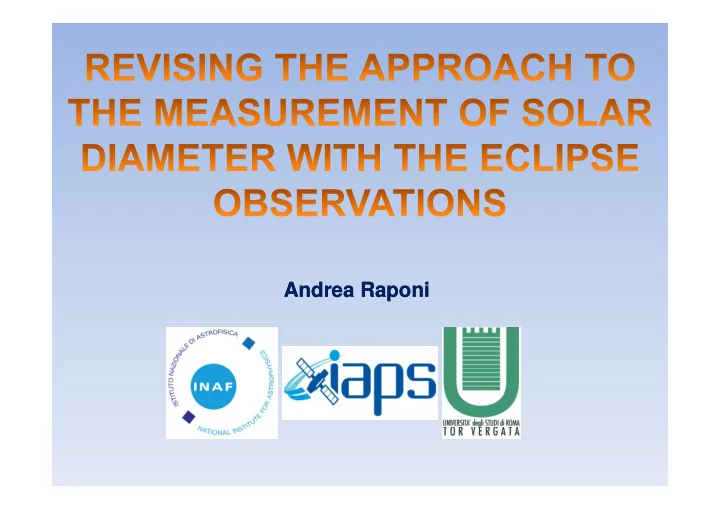

Andrea Raponi Andrea Raponi
SUMMARY 1. Problems with the Classical Method 2. Understanding the Light Curve of the Bead 2. Understanding the Light Curve of the Bead 3 3. An application of the revised method A li ti f th i d th d
1. Classical method (1/4) The Classical Method measures the solar radius considering Baily’s The Classical Method measures the solar radius considering Baily s beads like on ‐ off events the luminosity profile of the solar limb is a step function : when the beads appear (or disappear) the step has overcome the lunar edge in a lunar valley.
1. Classical method (2/4) The limb profile like a step function.. always reasonable? p p y Example: bead at AA = 177 ° during eclipse on 15 Jan 2010 A. Tegtemeier, India: the bead appears when the standard limb is 0.43 arcsec over the mean lunar limb R. Nugent, Uganda: the bead disappears when the standard limb is 0.72 arcsec under the mean lunar limb
1. Classical method (3/4) Explanation: Explanation: Different optical instruments have different sensitivity and different Signal / Noise ratio different Signal / Noise ratio The Limb Darkening Function is not a step profile : we can not consider the bead as an ON ‐ OFF signal
1. Classical method (4/4) We have to take into account the whole shape of the Limb Darkening We have to take into account the whole shape of the Limb Darkening Function (LDF). The Inflection Point Position of the LDF is the definition of the solar edge. LDF by Rogerson (1961)
2.Understanding The Light Curve of the Bead (1/3) We can consider the light curve of the bead as a convolution We can consider the light curve of the bead as a convolution between the LDF and the width of the lunar valley ω :
2.Understanding The Light Curve of the Bead (2/3) Width of the Lunar Valley Bead Light Curve g Distance between lunar edge and standard solar edge Ob i i Obtaining the Limb Darkening Function from the Bead Light Curve is h Li b D k i F i f h B d Li h C i not straightforward because one has to analyze the shape of the Lunar Valley (the function ω ) and perform the deconvolution Valley (the function ω ) and perform the deconvolution. But we can assume ω like a step function, namely the valley like a rectangle: 0 for x < y 0 for x < y ω = k for x > y First Derivative Linear transformation of the LDF, keeping its shape and thus its keeping its shape and thus its L(y)’ = k · LDF Inflection Point Position.
2.Understanding The Light Curve of the Bead (3/3) Summarizing up to here: Summarizing up to here: We have to detect the Limb Darkening Function to obtain the g Inflection Point Position: the LDF is not a step function. We assume the shape of the lunar valley like rectangular: ω is a We assume the shape of the lunar valley like rectangular: ω is a step function. This assumption does work! We assume the light curve of the bead forged solely by the LDF. Namely there are not instrumental or atmospheric effects. This assumption has to be verified case by case assumption has to be verified case by case. All we have to do to obtain the LDF is the first derivative of the whole light curve of the bead. If the inflection point is inside the LDF detected, we can infer a measure of the solar radius.
3. An application of the revised method (1/7) Select the useful part of the light curve f p f g Limovie l last frame: t f first frame: when the bell where the signal where the signal shape of the bead shape of the bead overcomes 5 σ of (3D window) the background reach its top noise
3. An application of the revised method (2/7) Find the relation: Frame ‐ UTC Time Limovie To plot the light curve of To plot the light curve of the bead in function of the time time = frame ∙ m + q time = frame ∙ m + q m = (time2 ‐ time1) / (frame2 ‐ frame1) ( ) / ( ) q = time1 ‐ frame1 ∙ m
3. An application of the revised method (3/7) Perform polynomial fits to flatten the noise f p y f f There are different functions that fit the light curve. Limovie We can take polynomial functions from 3 ° to 9 ° grade. W k l i l f i f 3 9 d Their differences are due to the electronic noise.
3. An application of the revised method (4/7) Find the relation: UTC Time – y ( Δ R) y ( ) To plot the light curve of Limovie the bead in function of Δ R the bead in function of Δ R. At this point we have some polynomial fits instead of the signal detected. y = time ∙ m + q y time m + q m = (y2 ‐ y1) / (time2 ‐ time1) q = y1 ‐ time1 ∙ m
3. An application of the revised method (5/7) Perform the first derivative to find the LDF f f f Limovie different polynomial fit of the light curve g different LDF profile each point has a distribution of values
3. An application of the revised method (6/7) Infer the Inflection Point Position: f f 8 bits dynamic range, diverse observations Limovie Eclipse 15 Jan 2010 A. Tegtmeier, lunar valley AA = 171 ° R Nugent lunar valley AA = 177 ° R. Nugent, lunar valley AA = 177
3. An application of the revised method (7/7) Infer the Inflection Point Position: f f 12 bits dynamic range, single observation Limovie First derivative of the LDF (second derivative of the light curve)
andr.raponi@gmail.com Thank you
Recommend
More recommend